A Scientometric Assessment of Agri-Food Technology for Research Activity and Productivity
Abstract
:1. Current Issues in Agri-Food Industry and Technology
2. Scientific and Technology Opportunities based on Scientometric Analysis
- What trends, technologies, and market opportunities exist in terms of technology clusters, sectors, and fields, and how are they interrelated?
- Who are the active players (i.e., countries and assignees) and what are the dynamics of patent activities to explore the research landscape?
3. Methodology and Data
3.1. Data Source
3.2. Data Cleaning
3.3. Data Analysis
3.4. Data Visualization
4. Results and Discussion
4.1. Evolution over Time
4.2. Technology Topic Analysis
4.2.1. Overall Technological Development
4.2.2. Technological Sectors and Fields
4.3. Country-Level Analysis
4.3.1. Countries’ Productivity
4.3.2. Market Opportunities by International Patent Filings
4.4. Assignee-Level Analysis
4.4.1. Assignees’ Productivity
4.4.2. Market Opportunities by Number of Citations
4.4.3. Collaboration Opportunities
5. Implications
5.1. Technology Development Opportunities
5.2. Collaboration Opportunities
5.3. Innovation Ecosystem
5.4. Limitations and Recommendations for Scientometric Analysis
6. Conclusions and Future Research
Author Contributions
Funding
Data Availability Statement
Acknowledgments
Conflicts of Interest
Appendix A
| No. | IPC Subgroups | Number of Records | % Share | Meaning |
|---|---|---|---|---|
| 1 | A23B 7/154 | 390 | 4.2% | Organic compounds; microorganisms; enzymes |
| 2 | A23B 7/16 | 262 | 2.8% | Coating with a protective layer; compositions or apparatus therefor |
| 3 | A23L 19/00 | 235 | 2.5% | Products from fruits or vegetables; preparation or treatment thereof |
| 4 | A23B 7/157 | 229 | 2.4% | Inorganic compounds |
| 5 | A23B 7/00 | 199 | 2.1% | Preservation or chemical ripening of fruit or vegetables |
| 6 | A23B 7/04 | 198 | 2.1% | Freezing; subsequent thawing; cooling |
| 7 | A23B 7/153 | 164 | 1.7% | Preserving or ripening with chemicals in the form of liquids or solids |
| 8 | A23B 7/10 | 144 | 1.5% | Preserving with acids; acid fermentation |
| 9 | A23B 7/148 | 126 | 1.3% | Preserving or ripening with chemicals in a controlled atmosphere, e.g., partial vacuum |
| 10 | A01F 25/00 | 100 | 1.1% | Storing agricultural or horticultural produce; hanging-up harvested fruit |
| Cluster | Technology Sector | Examples of Patent Titles and IPC Subclass Codes |
|---|---|---|
| 1 | Chemistry |
|
| 2 | Mechanical engineering |
|
| 3 | Instruments |
|
| 4 | Electrical engineering |
|
| 5 | Other fields |
|
References
- Food and Agriculture Organization of the United Nations. The Future of Food and Agriculture—Trends and Challenges; Food and Agriculture Organization of the United Nations: Rome, Italy, 2017. [Google Scholar]
- Food and Agriculture Organization of the United Nations. The State of Food and Agriculture; Food and Agriculture Organization of the United Nations: Rome, Italy, 2020. [Google Scholar]
- Food Loss and Food Waste. Available online: http://www.fao.org/food-loss-and-food-waste/en/ (accessed on 25 April 2021).
- Parfitt, J.; Barthel, M.; Macnaughton, S. Food waste within food supply chains: Quantification and potential for change to 2050. Philos. Trans. R. Soc. B 2010, 365, 3065–3081. [Google Scholar] [CrossRef] [Green Version]
- Ramos, B.; Miller, F.A.; Brandão, T.R.S.; Teixeira, P.; Silva, C.L.M. Fresh fruits and vegetables—An overview on applied methodologies to improve its quality and safety. Innov. Food Sci. Emerg. Technol. 2013, 20, 1–15. [Google Scholar] [CrossRef]
- Cooper, A.C.; Schendel, D. Strategic responses to technological threats. Bus. Horiz. 1976, 19, 61–69. [Google Scholar] [CrossRef]
- Mortara, L.; Thomson, R.; Moore, C.; Armara, K.; Kerr, C.; Phaal, R.; Probert, D. Developing a technology intelligence strategy at Kodak European Research: Scan & target. Res. Technol. Manag. 2010, 53, 27–38. [Google Scholar] [CrossRef]
- Yang, X.; Liu, X.; Song, J. A study on technology competition of graphene biomedical technology based on patent analysis. Appl. Sci. 2019, 9, 2613. [Google Scholar] [CrossRef] [Green Version]
- Schneider, N.; Lowe, D.M.; Sayle, R.A.; Tarselli, M.A.; Landrum, G.A. Big data from pharmaceutical patents: A computational analysis of medicinal chemists’ bread and butter. J. Med. Chem. 2016, 59, 4385–4402. [Google Scholar] [CrossRef] [PubMed]
- Quintero-Quintero, W.; Blanco-Ariza, A.B.; Garzón-Castrillón, M.A. Intellectual capital: A review and bibliometric analysis. Publications 2021, 9, 46. [Google Scholar] [CrossRef]
- Asche, G. “80% of technical information found only in patents”—Is there proof of this? World Pat. Inf. 2017, 48, 16–28. [Google Scholar] [CrossRef]
- Ogawa, T.; Kajikawa, Y. Assessing the industrial opportunity of academic research with patent relatedness: A case study on polymer electrolyte fuel cells. Technol. Forecast. Soc. Chang. 2015, 90, 469–475. [Google Scholar] [CrossRef] [Green Version]
- Kim, Y.G.; Suh, J.H.; Park, S.C. Visualization of patent analysis for emerging technology. Expert Syst. Appl. 2008, 34, 1804–1812. [Google Scholar] [CrossRef]
- Ju, Y.; Sohn, S.Y. Patent-based QFD framework development for identification of emerging technologies and related business models: A case of robot technology in Korea. Technol. Forecast. Soc. Chang. 2015, 94, 44–64. [Google Scholar] [CrossRef]
- Chakraborty, M.; Byshkin, M.; Crestani, F. Patent citation network analysis: A perspective from descriptive statistics and ERGMs. PLoS ONE 2020, 15, e0241797. [Google Scholar] [CrossRef]
- World Intellectual Property Organization. Guide to the International Patent Classification; World Intellectual Property Organization: Geneva, Switzerland, 2020. [Google Scholar]
- Hwang, J.-T.; Kim, B.-K.; Jeong, E.-S. Patent value and survival of patents. J. Open Innov. Technol. Mark. Complex. 2021, 7, 119. [Google Scholar] [CrossRef]
- Scherer, F.M.; Harhoff, D. Technology policy for a world of skew-distributed outcomes. Res. Pol. 2000, 29, 559–566. [Google Scholar] [CrossRef]
- Chen, Y.-S.; Chang, K.-C. Exploring the nonlinear effects of patent citations, patent share and relative patent position on market value in the US pharmaceutical industry. Technol. Anal. Strateg. Manag. 2010, 22, 153–169. [Google Scholar] [CrossRef]
- Rashid, S.; Khattak, A.; Ashiq, M.; Ur Rehman, S.; Rashid Rasool, M. Educational landscape of virtual reality in higher education: Bibliometric evidences of publishing patterns and emerging trends. Publications 2021, 9, 17. [Google Scholar] [CrossRef]
- Oliveira, C.Y.B.; Oliveira, C.D.L.; Müller, M.N.; Santos, E.P.; Dantas, D.M.M.; Gálvez, A.O. A scientometric overview of global dinoflagellate research. Publications 2020, 8, 50. [Google Scholar] [CrossRef]
- Chae, S.; Gim, J. A study on trend analysis of applicants based on patent classification systems. Information 2019, 10, 364. [Google Scholar] [CrossRef] [Green Version]
- Liu, W.; Tao, Y.; Yang, Z.; Bi, K. Exploring and visualizing the patent collaboration network: A case study of smart grid field in China. Sustainability 2019, 11, 465. [Google Scholar] [CrossRef] [Green Version]
- Mikhailov, O.V. Introduction from the guest editor of special issue “modern problems of scientometric assessment of publication activity”. Publications 2021, 9, 19. [Google Scholar] [CrossRef]
- Tatry, M.-V.; Fournier, D.; Jeannequin, B.; Dosba, F. EU27 and USA leadership in fruit and vegetable research: A bibliometric study from 2000 to 2009. Scientometrics 2014, 98, 2207–2222. [Google Scholar] [CrossRef]
- Daim, T.U.; Rueda, G.; Martin, H.; Gerdsri, P. Forecasting emerging technologies: Use of bibliometrics and patent analysis. Technol. Forecast. Soc. Chang. 2006, 73, 981–1012. [Google Scholar] [CrossRef]
- Florêncio, M.N.d.S.; Gomes, P.C.d.S.; Abud, A.K.d.S.; Oliveira, A.M.D., Jr. Innovation, research and development on the passion fruit peel flour: Bibliometric approach. Food Sci. Technol. 2020, 40, 130–135. [Google Scholar] [CrossRef] [Green Version]
- Ma, L.; Zhang, M.; Bhandari, B.; Gao, Z. Recent developments in novel shelf life extension technologies of fresh-cut fruits and vegetables. Trends Food Sci. Technol. 2017, 64, 23–38. [Google Scholar] [CrossRef] [Green Version]
- Yousuf, B.; Deshi, V.; Ozturk, B.; Siddiqui, M.W. Fresh-cut fruits and vegetables: Quality issues and safety concerns. In Fresh-Cut Fruits and Vegetables; Siddiqui, M.W., Ed.; Academic Press: Cambridge, MA, USA, 2020; pp. 1–15. [Google Scholar] [CrossRef]
- Castellanos, O.F.; Torres, L.M. Technology intelligence: Methods and capabilities for generation of knowledge and decision making. In Proceedings of the PICMET 2010 Technology Management for Global Economic Growth, Phuket, Thailand, 18–22 July 2010; pp. 1–9. [Google Scholar]
- Chen, N.; Liu, Y.; Cheng, Y.; Liu, L.; Yan, Z.; Tao, L.; Guo, X.; Luo, Y.; Yan, A. Technology resource, distribution, and development characteristics of global influenza virus vaccine: A patent bibliometric analysis. PLoS ONE 2015, 10, e0136953. [Google Scholar] [CrossRef]
- Porter, A.L.; Youtie, J.; Shapira, P.; Schoeneck, D.J. Refining search terms for nanotechnology. J. Nanopart. Res. 2008, 10, 715–728. [Google Scholar] [CrossRef]
- LexisNexis TotalPatent. Available online: http://www.lexisnexis.com/pdf/total-patent-overview.pdf (accessed on 30 November 2021).
- Thavorn, J.; Gowanit, C.; Muangsin, V.; Muangsin, N. Foresight through strategic technology intelligence for collaboration and innovation pathways. In Proceedings of the ISPIM Connects Bangkok—Partnering for an Innovative Community, Bangkok, Thailand, 1–4 March 2020; pp. 1–16. [Google Scholar]
- Porter, A.L.; Cunningham, S.W. Tech Mining: Exploiting New Technologies for Competitive Advantage; John Wiley & Sons, Inc.: Hoboken, NJ, USA, 2005. [Google Scholar]
- Thavorn, J.; Gowanit, C.; Muangsin, V.; Muangsin, N. Collaboration network and trends of global coronavirus disease research: A scientometric analysis. IEEE Access 2021, 9, 45001–45016. [Google Scholar] [CrossRef]
- Aria, M.; Cuccurullo, C. bibliometrix: An R-tool for comprehensive science mapping analysis. J. Informetr. 2017, 11, 959–975. [Google Scholar] [CrossRef]
- Aria, M.; Misuraca, M.; Spano, M. Mapping the evolution of social research and data science on 30 years of social indicators research. Soc. Indic. Res. 2020, 149, 803–831. [Google Scholar] [CrossRef]
- Yuan, C.; Yang, H. Research on K-value selection method of K-means clustering algorithm. J 2019, 2, 16. [Google Scholar] [CrossRef] [Green Version]
- Kara, M.E.; Oktay Fırat, S.Ü. Supplier risk assessment based on best-worst method and K-means clustering: A case study. Sustainability 2018, 10, 1066. [Google Scholar] [CrossRef] [Green Version]
- Ampornphan, P.; Tongngam, S. Exploring technology influencers from patent data using association rule mining and social network analysis. Information 2020, 11, 333. [Google Scholar] [CrossRef]
- Achour, M. A new method to assess the quality degradation of food products during storage. J. Food Eng. 2006, 75, 560–564. [Google Scholar] [CrossRef]
- Labuza, T.P.; Schmidl, M.K. Accelerated shelf life testing of foods. Food Technol. 1985, 39, 57–64. [Google Scholar]
- Byun, J.; Sung, T.-E.; Park, H.-W. Technological innovation strategy: How do technology life cycles change by technological area. Technol. Anal. Strateg. Manag. 2018, 30, 98–112. [Google Scholar] [CrossRef]
- Haupt, R.; Kloyer, M.; Lange, M. Patent indicators for the technology life cycle development. Res. Pol. 2007, 36, 387–398. [Google Scholar] [CrossRef]
- Tong, T.W.; Zhang, K.; He, Z.-L.; Zhang, Y. What determines the duration of patent examination in China? An outcome-specific duration analysis of invention patent applications at SIPO. Res. Pol. 2018, 47, 583–591. [Google Scholar] [CrossRef]
- Tang, L.; Shapira, P.; Youtie, J. Is there a clubbing effect underlying Chinese research citation increases? J. Assoc. Inf. Sci. Technol. 2015, 66, 1923–1932. [Google Scholar] [CrossRef] [Green Version]
- World Intellectual Property Organization. World Intellectual Property Indicators 2016; World Intellectual Property Organization: Geneva, Switzerland, 2016. [Google Scholar]
- Hakobyan, S. Overview of Manufacturing Industry in Russia; Deloitte CIS Research Centre: Moscow, Russia, 2017. [Google Scholar]
- European Committee for Standardization (CEN). Indian Electrical Equipment Including Consumer Electronics Industry; European Committee for Standardization (CEN): Brussels, Belgium, 2019. [Google Scholar]
- Martínez, C. Patent families: When do different definitions really matter? Scientometrics 2011, 86, 39–63. [Google Scholar] [CrossRef]
- Ma, T.; Porter, A.L.; Guo, Y.; Ready, J.; Xu, C.; Gao, L. A technology opportunities analysis model: Applied to dye-sensitised solar cells for China. Technol. Anal. Strateg. Manag. 2014, 26, 87–104. [Google Scholar] [CrossRef]
- Xia, C.; Nelson, R. Exploring Australia’s Comparative Advantage for Exporting Fresh Produce; Department of Agriculture and Water Resources: Canberra, ACT, Australia, 2018; pp. 176–198. [Google Scholar]
- World Intellectual Property Organization. Patent Cooperation Treaty Yearly Review 2020: The International Patent System; World Intellectual Property Organization: Geneva, Switzerland, 2020. [Google Scholar]
- Buchner, G.A.; Stepputat, K.J.; Zimmermann, A.W.; Schomäcker, R. Specifying technology readiness levels for the chemical industry. Ind. Eng. Chem. Res. 2019, 58, 6957–6969. [Google Scholar] [CrossRef]
- Siegel, D.S.; Veugelers, R.; Wright, M. Technology transfer offices and commercialization of university intellectual property: Performance and policy implications. Oxford Rev. Econ. Pol. 2007, 23, 640–660. [Google Scholar] [CrossRef]
- Hayes, A. When Universities Patent Their Research. Available online: https://www.ipwatchdog.com/2017/11/20/universities-patent-research/id=90200/ (accessed on 20 July 2021).
- Shi, T.; Sun, J.; Wu, X.; Weng, J.; Wang, P.; Qie, H.; Huang, Y.; Wang, H.; Gao, Z. Transcriptome analysis of Chinese bayberry (Myrica rubra Sieb. et Zucc.) fruit treated with heat and 1-MCP. Plant Physiol. Biochem. 2018, 133, 40–49. [Google Scholar] [CrossRef] [PubMed]
- Zhao, H.-Y.; Yang, G.-L.; Liu, Y.-L.; Ye, H.-P.; Qi, X.-J.; Wang, Q. Residual behavior and risk assessment of prochloraz in bayberries and bayberry wine for the Chinese population. Environ. Monit. Assess. 2019, 191, 644. [Google Scholar] [CrossRef] [PubMed]
- Chung, E.; Kwon, N.; Lee, J. Understanding scientific collaboration in the research life cycle: Bio- and nanoscientists’ motivations, information-sharing and communication practices, and barriers to collaboration. J. Assoc. Inf. Sci. Technol. 2016, 67, 1836–1848. [Google Scholar] [CrossRef]
- Schneider, C. Fences and competition in patent races. Int. J. Ind. Organ. 2008, 26, 1348–1364. [Google Scholar] [CrossRef] [Green Version]
- Ziedonis, R.H. Don’t fence me in: Fragmented markets for technology and the patent acquisition strategies of firms. Manag. Sci. 2004, 50, 804–820. [Google Scholar] [CrossRef] [Green Version]
- Galvao, A.; Mascarenhas, C.; Marques, C.; Ferreira, J.; Ratten, V. Triple helix and its evolution: A systematic literature review. J. Sci. Technol. Policy Manag. 2019, 10, 812–833. [Google Scholar] [CrossRef]
- Holgersson, M.; Aaboen, L. A literature review of intellectual property management in technology transfer offices: From appropriation to utilization. Technol. Soc. 2019, 59, 101132. [Google Scholar] [CrossRef]
- Dykeman, D.J.; Abramson, D.T. Patent strategies for life sciences companies to navigate the changing patent landscape. J. Commer. Biotechnol. 2011, 17, 358–364. [Google Scholar] [CrossRef]
- Cao, Y.; Zhao, L. Analysis of patent management effects on technological innovation performance. Balt. J. Manag. 2013, 8, 286–305. [Google Scholar] [CrossRef]
- Cary, M.; Rockwell, T. International collaboration in open access publications: How income shapes international collaboration. Publications 2020, 8, 13. [Google Scholar] [CrossRef] [Green Version]
- Etzkowitz, H. Incubation of incubators: Innovation as a triple helix of university-industry-government networks. Sci. Public Policy 2002, 29, 115–128. [Google Scholar] [CrossRef]
- Kongsoontornkijkul, K.; Pichyangkura, R.; Vadhanasindhu, P.; Vanichbuncha, K. Developing A mobile web for innovative university assessment system: Thailand talent mobility programme. Int. J. Interact. Mob. Technol. 2019, 13, 34–50. [Google Scholar] [CrossRef]
- Qiao, P.-H.; Ju, X.-F.; Fung, H.-G. Industry association networks, innovations, and firm performance in Chinese small and medium-sized enterprises. China Econ. Rev. 2014, 29, 213–228. [Google Scholar] [CrossRef]
- Choi, Y.; Park, S.; Lee, S. Identifying emerging technologies to envision a future innovation ecosystem: A machine learning approach to patent data. Scientometrics 2021, 126, 5431–5476. [Google Scholar] [CrossRef]

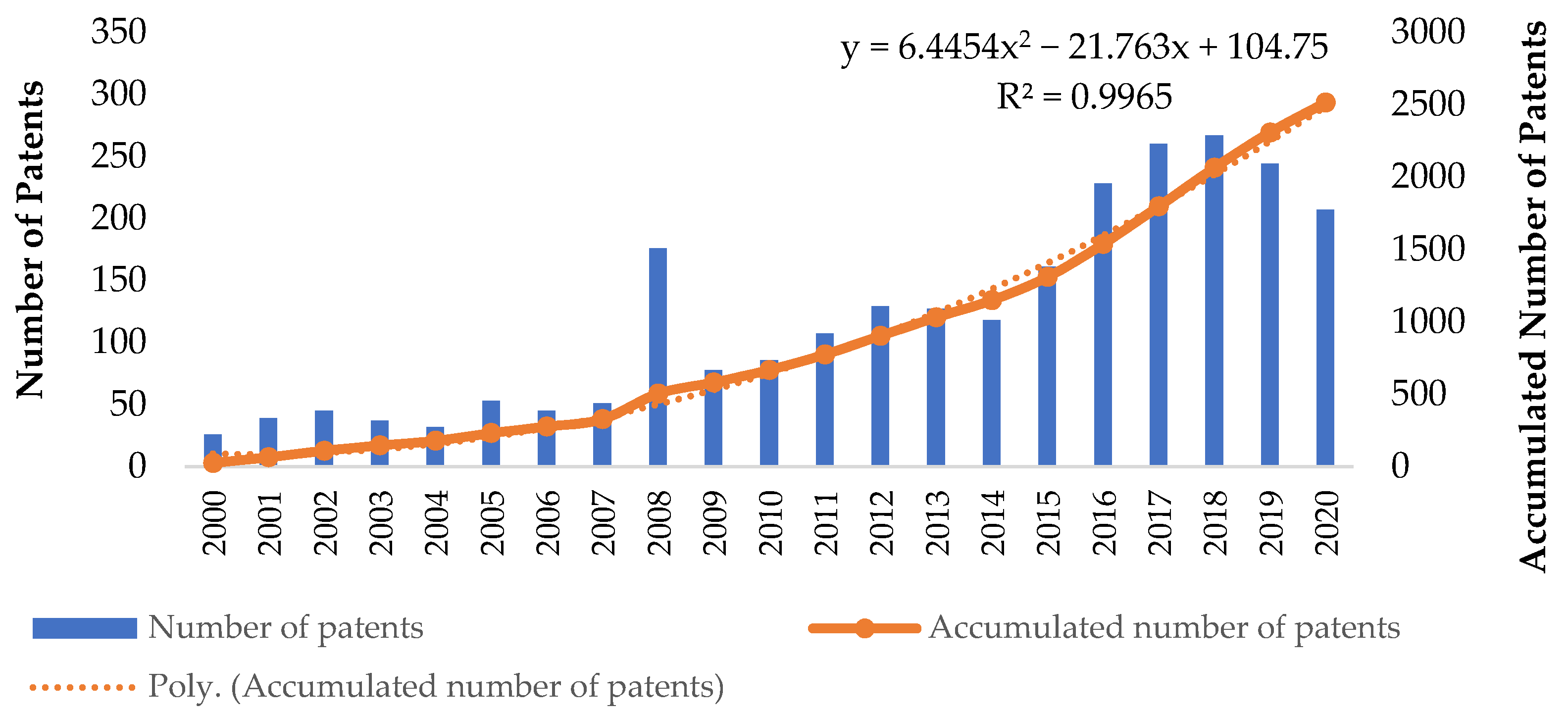

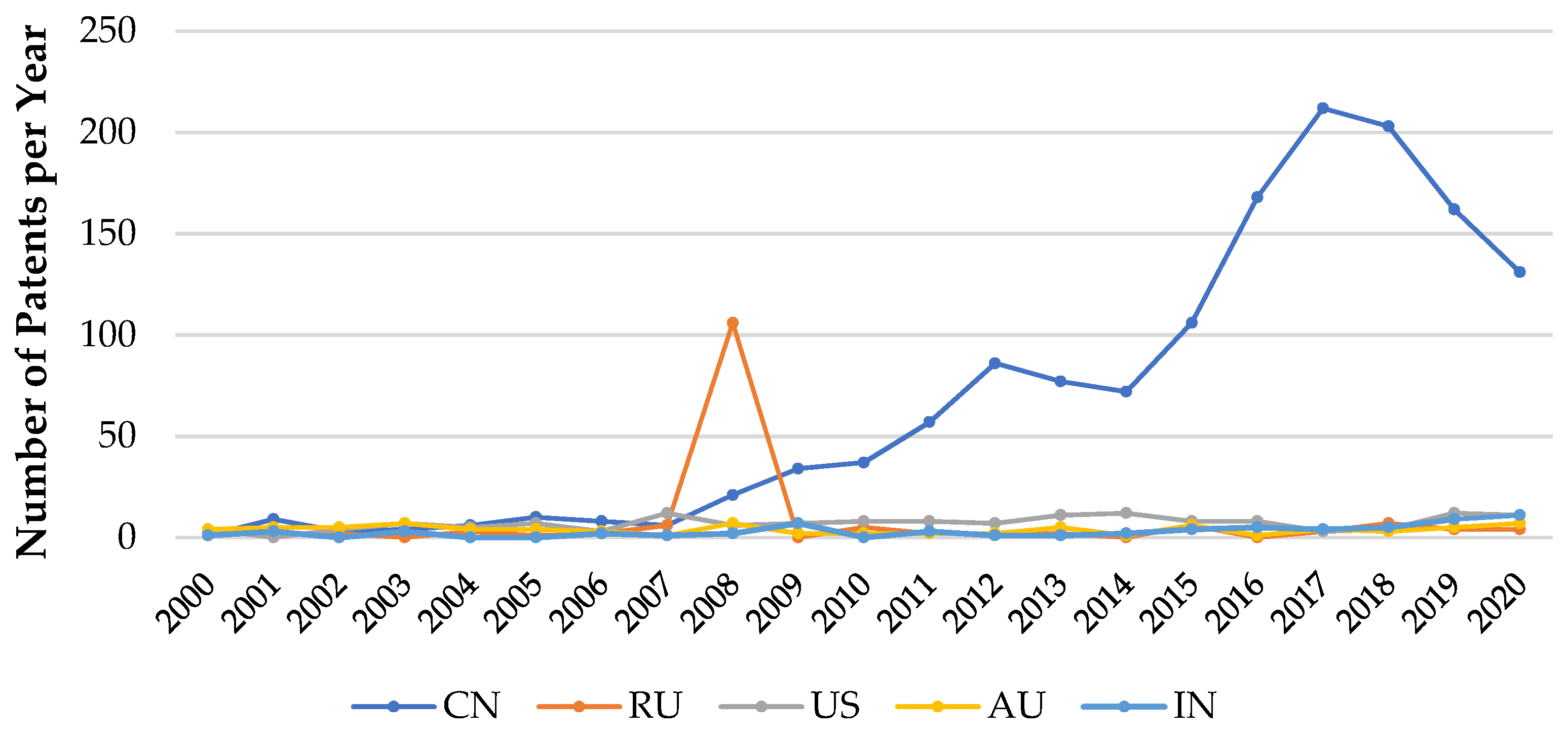
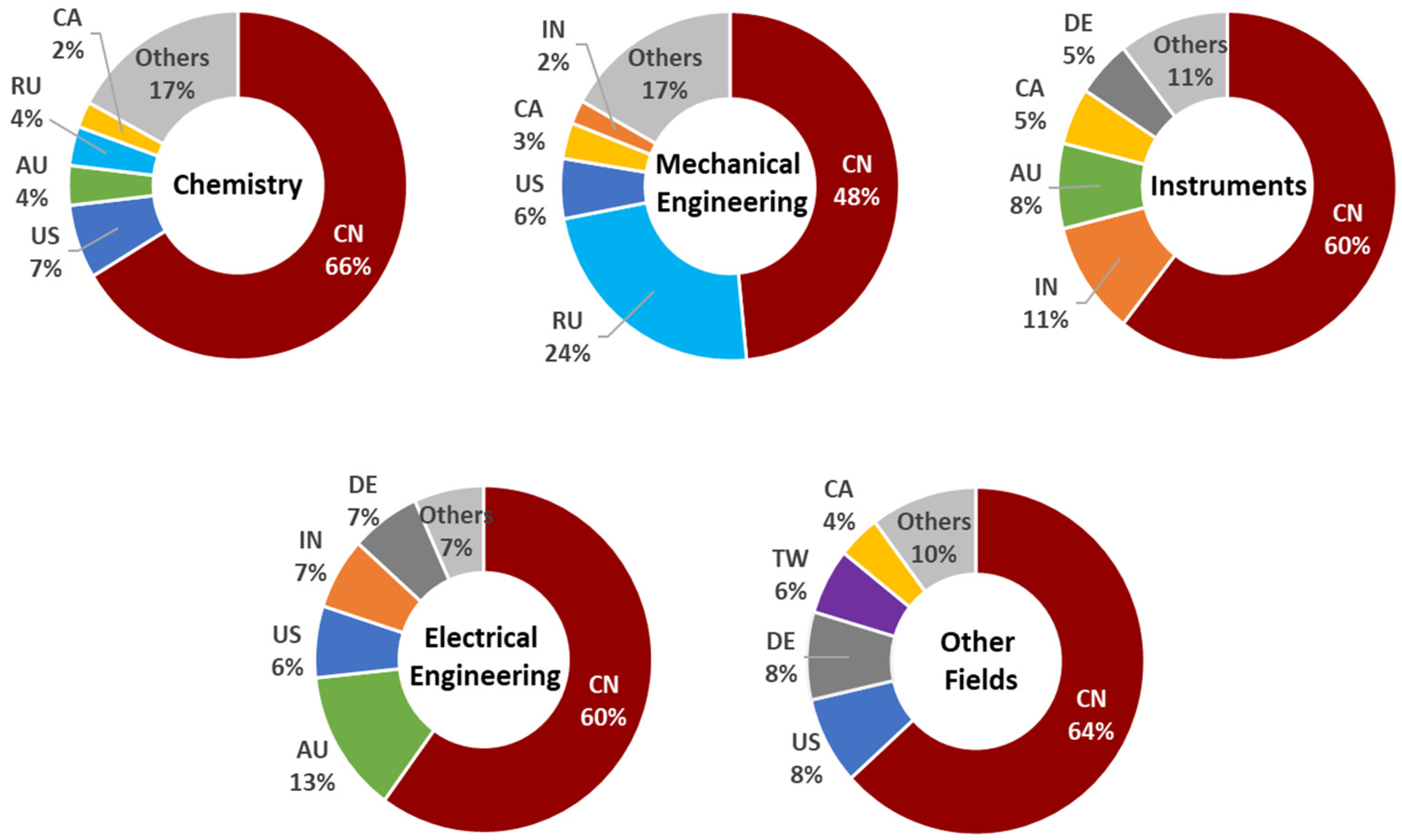
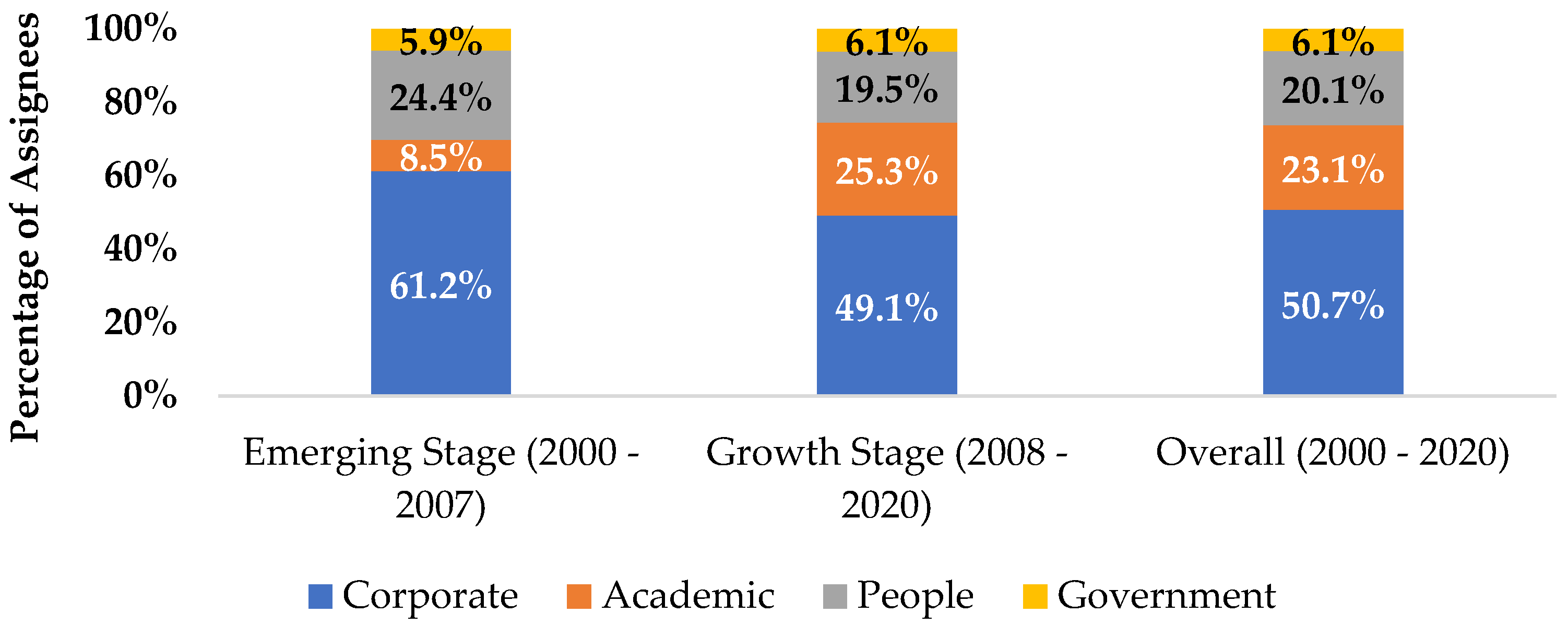
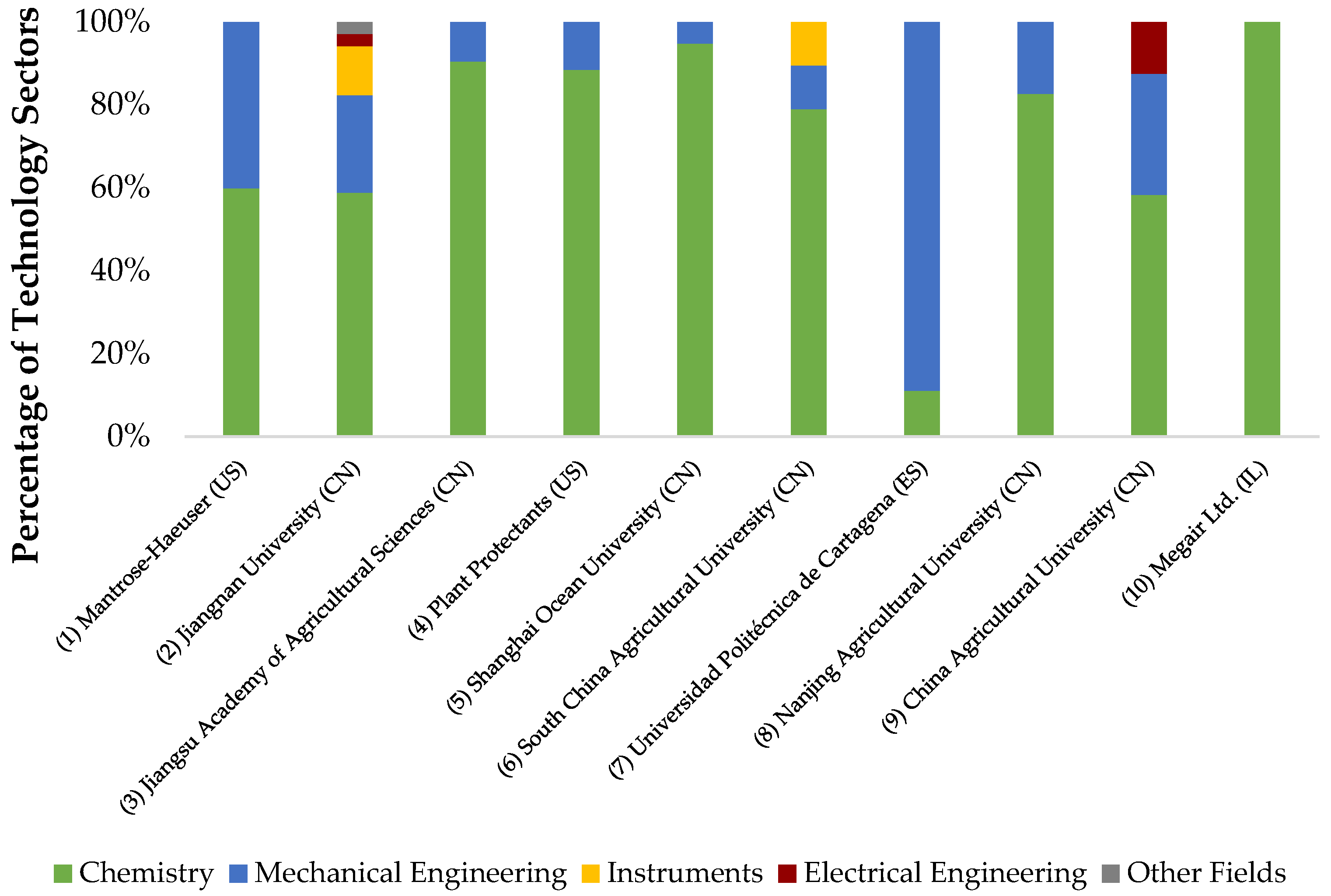
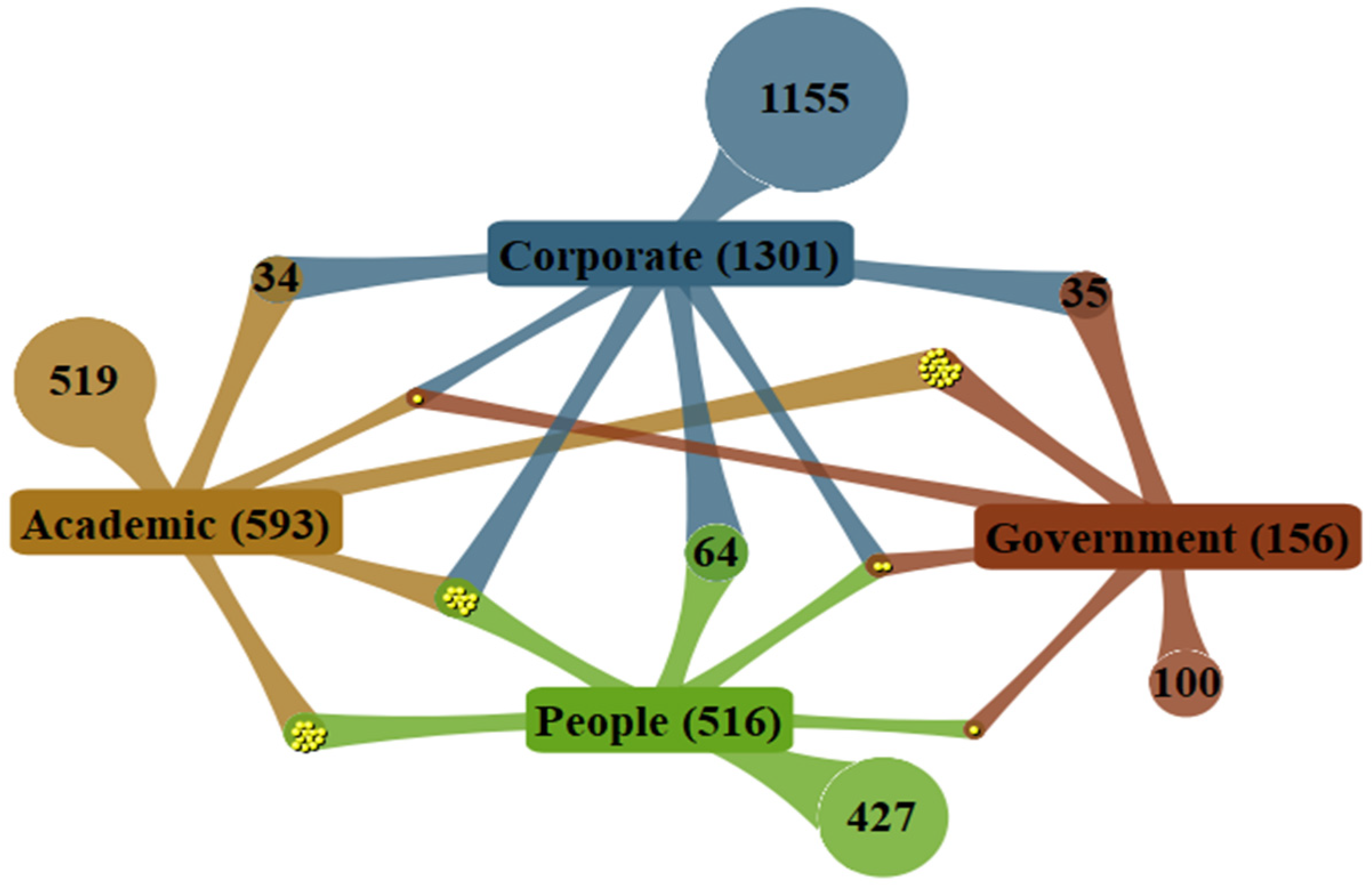
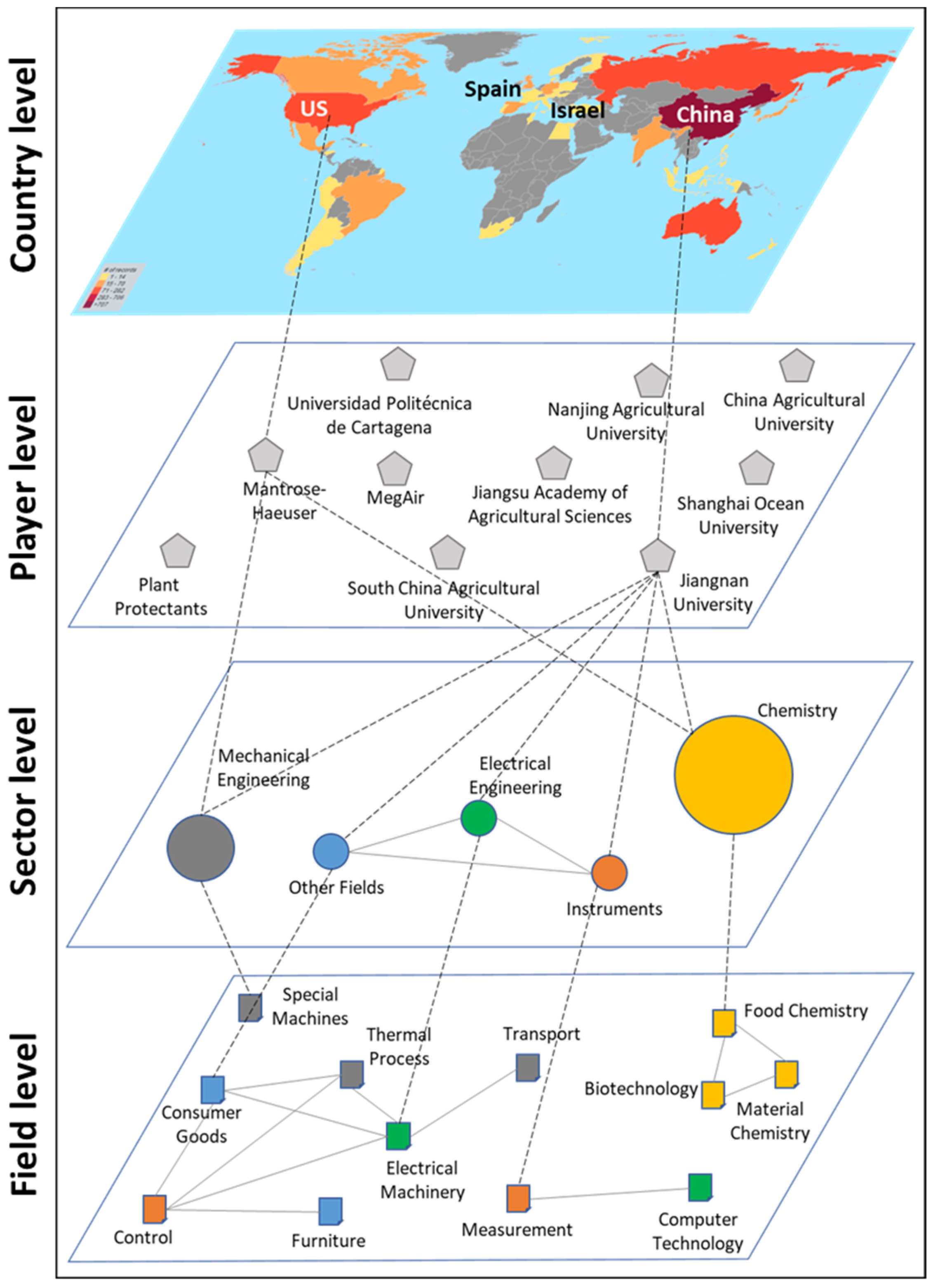
| TLC Stage | Number of Patents | Mean Value of the Duration (years) | Standard Deviation | Standard Error Mean |
|---|---|---|---|---|
| Emerging | 328 | 3.18 | 2.07 | 0.11 |
| Growth | 2188 | 2.39 | 1.97 | 0.04 |
| Variance Assumption | Levene’s Test | t-Test | ||
|---|---|---|---|---|
| F-Value | p-Value | t | p-Value | |
| Equal variances assumed | 12.436 | .000 | 6.708 | .000 |
| Equal variances not assumed | - | - | 6.459 | .000 |
| Cluster | Technology Sector | Technology Field | IPC Subclass Codes |
|---|---|---|---|
| 1 | Chemistry | Food chemistry | A01H, A21D, A23B, A23C, A23D, A23F, A23G, A23K, A23L, C12C, C12G, C12H, C12J |
| Basic materials chemistry | A01N, A01P, C05B, C05D, C05F, C05G, C09D, C09J, C09K, C10M, C11B, C11D, C99Z | ||
| Pharmaceuticals | A61K, A61P | ||
| Organic fine chemistry | A61K, A61Q, C07C, C07D, C07F, C07H | ||
| Chemical engineering | B01D, B01J, B07B, B07C, B08B, D06B, F26B | ||
| Environmental technology | B01D, B09B, B09C, C02F | ||
| Surface and coating | B05D, B32B | ||
| Micro-structural and nanotechnology | B82Y | ||
| Materials and metallurgy | C01B, C01F | ||
| Biotechnology | C07G, C07K, C12N, C12P, C12Q, C12R, C12S | ||
| Macromolecular chemistry and polymers | C08B, C08F, C08G, C08K, C08L | ||
| 2 | Mechanical engineering | Other special machines | A01C, A01D, A01F, A01G, A01K, A22C, A23N, A23P, B29B, B29C, B29D, C08J |
| Machine tools | A62D, B23K, B26D | ||
| Engines, pumps, turbines | B31B, B41J, D01D, D01F, D06M, D21B, D21H | ||
| Transport | B60H, B60P, B60S, B61B, B61K, B62B, B62D | ||
| Handling | B65B, B65D | ||
| Thermal processes and apparatus | F24F, F24J, F24S, F25B, F25C, F28D | ||
| 3 | Instruments | Medical technology | A61H, A61J, A61L, G16H |
| Measurement | G01D, G01K, G01N | ||
| Analysis of biological materials | G01N | ||
| Control | G05B, G05D, G07F | ||
| 4 | Electrical engineering | Electrical machinery | F21K, F21S, F21V, F21Y, H01H, H02J, H05B |
| Computer technology | G06F, G06K, G06N, G06T | ||
| IT methods for management | G06Q | ||
| Telecommunications | H04H | ||
| Digital communication | H04L, H04W | ||
| Audio-visual technology | H04N, H04R | ||
| 5 | Other fields | Other consumer goods | A24B, A24C, A24D, A99Z, D06N, D07B, F25D |
| Furniture | A47B, A47C, A47F, A47G, A47J | ||
| Civil engineering | E04H |
| No. | Country | Overall | Emerging Stage | Growth Stage | |||
|---|---|---|---|---|---|---|---|
| NP | % Share | NP | % Share | NP | % Share | ||
| 1 | China | 1413 | 56.2% | 47 | 14.3% | 1366 | 62.4% |
| 2 | Russia | 159 | 6.3% | 18 | 5.5% | 141 | 6.4% |
| 3 | US | 147 | 5.8% | 42 | 12.8% | 105 | 4.8% |
| 4 | Australia | 80 | 3.2% | 33 | 10.1% | 47 | 2.1% |
| 5 | India | 64 | 2.5% | 10 | 3.0% | 54 | 2.5% |
| 6 | Canada | 53 | 2.1% | 13 | 4.0% | 40 | 1.8% |
| 7 | Korea | 45 | 1.8% | 10 | 3.0% | 35 | 1.6% |
| 8 | Mexico | 37 | 1.5% | 7 | 2.1% | 30 | 1.4% |
| 9 | Brazil | 31 | 1.2% | 5 | 1.5% | 26 | 1.2% |
| 10 | Japan | 26 | 1.0% | 10 | 3.0% | 16 | 0.7% |
| Original Countries | Target Countries, Regions, or Organizations | |||||||||||
|---|---|---|---|---|---|---|---|---|---|---|---|---|
| CN | US | WO | PC | RU | IN | GB | AU | EP | IL | CA | Total | |
| CN | 1368 | 29 | 27 | 25 | - | - | 4 | 2 | 6 | 3 | 1 | 1465 |
| RU | - | 5 | 6 | - | 151 | - | - | - | 1 | - | 1 | 164 |
| US | 1 | 119 | 35 | 33 | - | 1 | 2 | 5 | 3 | 6 | 1 | 206 |
| AU | 3 | 46 | 66 | 11 | - | 1 | 7 | 15 | - | 6 | - | 155 |
| IN | - | 6 | 5 | 3 | - | 49 | 4 | 1 | - | - | - | 68 |
| CA | - | 31 | 46 | 46 | - | - | 2 | 2 | 2 | 3 | 10 | 142 |
| KR | 1 | 14 | 15 | 13 | - | - | 2 | 1 | 3 | 1 | - | 50 |
| MX | - | 17 | 22 | 8 | - | - | - | - | 1 | - | 2 | 50 |
| BR | - | 20 | 20 | 11 | - | - | - | 1 | 1 | 3 | - | 56 |
| JP | 1 | 19 | 19 | - | - | - | 1 | 2 | 2 | - | - | 44 |
| Total | 1374 | 306 | 261 | 150 | 151 | 51 | 22 | 29 | 19 | 22 | 15 | - |
| No. | Assignee | Origin Country | Patent Number |
|---|---|---|---|
| 1 | China Agricultural University | China | CN105941601A |
| 2 | Guangxi Shenlong Agriculture and Animal Husbandry Food Group Co., Ltd. | China | CN105613724A |
| 3 | Yangzhou University | China | CN107183150A |
| 4 | Zhejiang University | China | CN103583675A |
| 5 | Zhejiang University | China | CN103583675B |
| 6 | Chinese Academy of Agricultural Sciences | China | CN104886233A |
| 7 | Jiangsu Academy of Agricultural Sciences | China | CN106165720A |
| 8 | NatureSeal, Inc. | US | CN106998716A |
| 9 | Hefei Huiminghan Ecological Agriculture Technology Co., Ltd. | China | CN107047749A |
| 10 | Maruha Nichiro Corporation | Japan | CN107529769A |
Publisher’s Note: MDPI stays neutral with regard to jurisdictional claims in published maps and institutional affiliations. |
© 2021 by the authors. Licensee MDPI, Basel, Switzerland. This article is an open access article distributed under the terms and conditions of the Creative Commons Attribution (CC BY) license (https://creativecommons.org/licenses/by/4.0/).
Share and Cite
Thavorn, J.; Muangsin, V.; Gowanit, C.; Muangsin, N. A Scientometric Assessment of Agri-Food Technology for Research Activity and Productivity. Publications 2021, 9, 57. https://doi.org/10.3390/publications9040057
Thavorn J, Muangsin V, Gowanit C, Muangsin N. A Scientometric Assessment of Agri-Food Technology for Research Activity and Productivity. Publications. 2021; 9(4):57. https://doi.org/10.3390/publications9040057
Chicago/Turabian StyleThavorn, Jakkrit, Veera Muangsin, Chupun Gowanit, and Nongnuj Muangsin. 2021. "A Scientometric Assessment of Agri-Food Technology for Research Activity and Productivity" Publications 9, no. 4: 57. https://doi.org/10.3390/publications9040057
APA StyleThavorn, J., Muangsin, V., Gowanit, C., & Muangsin, N. (2021). A Scientometric Assessment of Agri-Food Technology for Research Activity and Productivity. Publications, 9(4), 57. https://doi.org/10.3390/publications9040057






